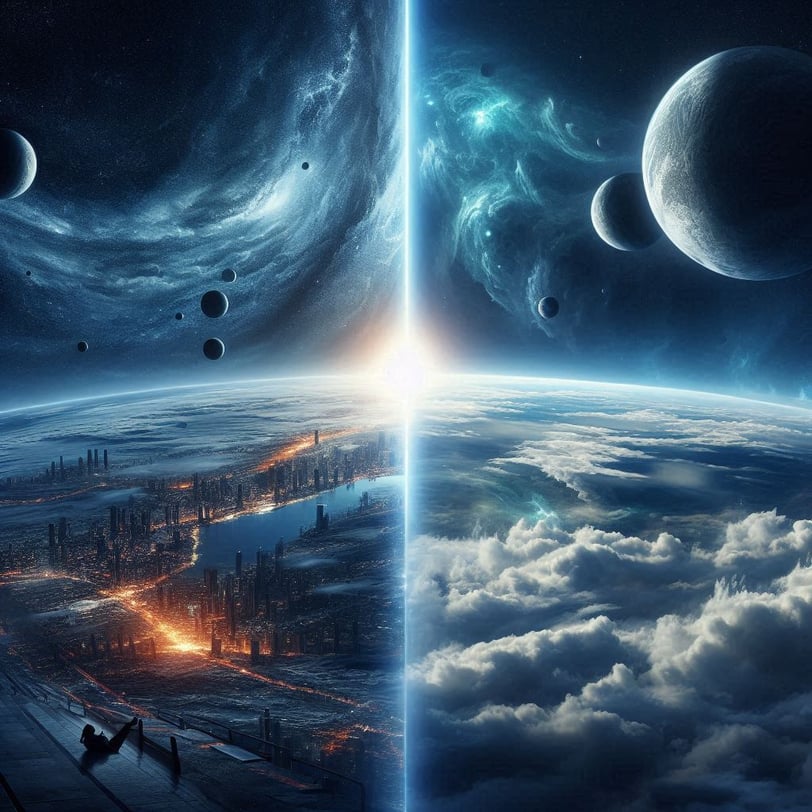alternative theories to the big bang
SCIENCETHE BIG BANGTHEORY
5/4/20243 min read


So, the Big Bang theory is great, but aside from that are there any other theories that can explain how our universe was created..?
Simply put, yes, and I have outlined just some of them, the most notable (and imaginative) below. These alternative theories offer different perspectives and interpretations of our cosmic origins, and as we don't know for sure 100% that the Big Bang is how our universe was created, read on, and let your imagination run wild...
Steady State Theory: Proposed in the mid-20th century, the Steady State Theory suggests that the universe has no beginning or end and has always existed in a state of continuous expansion. In this model, new matter is continuously created to maintain a constant density of matter throughout the universe. However, as it was discovered that the universe is continuously cooling and expanding rather than existing in a steady state of non-movement, this theory has been largely disproven.
Cyclic Universe Theory: This theory suggests that the universe undergoes cycles of expansion and contraction, where each cycle begins with a Big Bang and ending with a “Big Crunch”, where everything in the universe is drawn into one inescapable singularity. After the universe collapses in on itself, it rebounds and begins a new cycle of expansion, potentially leading to a new Big Bang and the creation of a brand new (or at least, recycled) universe.
Multiverse Hypothesis: As popularized in recent popular TV shows and films, the Multiverse Hypothesis proposes that our universe is just one of many potentially infinite universes existing simultaneously, each with its own set of physical laws and properties such as the strength of gravity, the speed of light, or the number of dimensions. These multiple universes could have been created through various mechanisms, such as cosmic inflation or quantum fluctuations.
Another concept within the multiverse theory is that of parallel universes. These universes may exist alongside our own, occupying the same space but separated by extra dimensions or other properties that prevent interaction between them, meaning we will never know they exist unless we find a way to travel or interact through hidden dimensions, which may or may not exist.
Emergent Universe Theory: This theory suggests that the universe emerges from a pre-existing state through a process of self-organization or emergence. In this model, our universe "emerged" from a pre-existing state through a process of cosmic evolution. It suggests that the universe did not have a singular beginning like the Big Bang but instead arose from earlier cosmic conditions. What these earlier cosmic conditions might have been are unknown to the scientific community as we currently don't know what, if anything, existed before the Big Bang, but could have been a quantum fluctuation, a higher-dimensional space, or some other form of existence beyond our current understanding.
Brane Theory (or M-Theory): In brane theory, space-time may have more dimensions than the familiar three spatial dimensions (length, width, and height) and one time dimension of which we as humans are aware and exist within. These extra dimensions are hypothesized to be compactified or curled up at incredibly small scales, making them currently unobservable to humans. It is proposed that our universe is a four-dimensional "brane" embedded within a higher-dimensional space called the "bulk." The collision or interaction of branes in higher-dimensional space could have triggered the creation of the universe.
This one is a little difficult to explain, but the video below does it well. Take a watch!
Quantum Cosmology: Quantum cosmology attempts to describe the origin of the universe using principles of quantum mechanics. Some quantum cosmological models propose that the universe may have emerged from a state of quantum uncertainty, with no definite beginning or end, the possibility that the universe emerged from a quantum state rather than a classical singularity, as described by classical general relativity. This could lead to insights into the nature of space, time, and the origin of the universe itself.
The Simulation Idea: The simulation hypothesis posits that our reality could be a computer-generated simulation rather than base reality. Originating from philosopher Nick Bostrom's "simulation argument," it suggests that advanced civilizations could create simulations indistinguishable from reality. This idea, fuelled by technological advancements, raises profound philosophical questions about the nature of our universe, existence, consciousness, and free will. While some physicists explore the concept as a thought experiment, the hypothesis lacks empirical evidence and remains speculative.
These alternative theories offer different perspectives on the origin and evolution of the universe, and each has its own strengths, weaknesses, and implications for our understanding of our own universe's cosmic origins, and maybe that of others. Ongoing research and observations aim to test and refine these theories, ultimately leading to a more complete understanding of the cosmos, although as of the present day, the Big Bang theory is our best explanation about where we all came from, and what our future holds.


